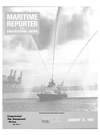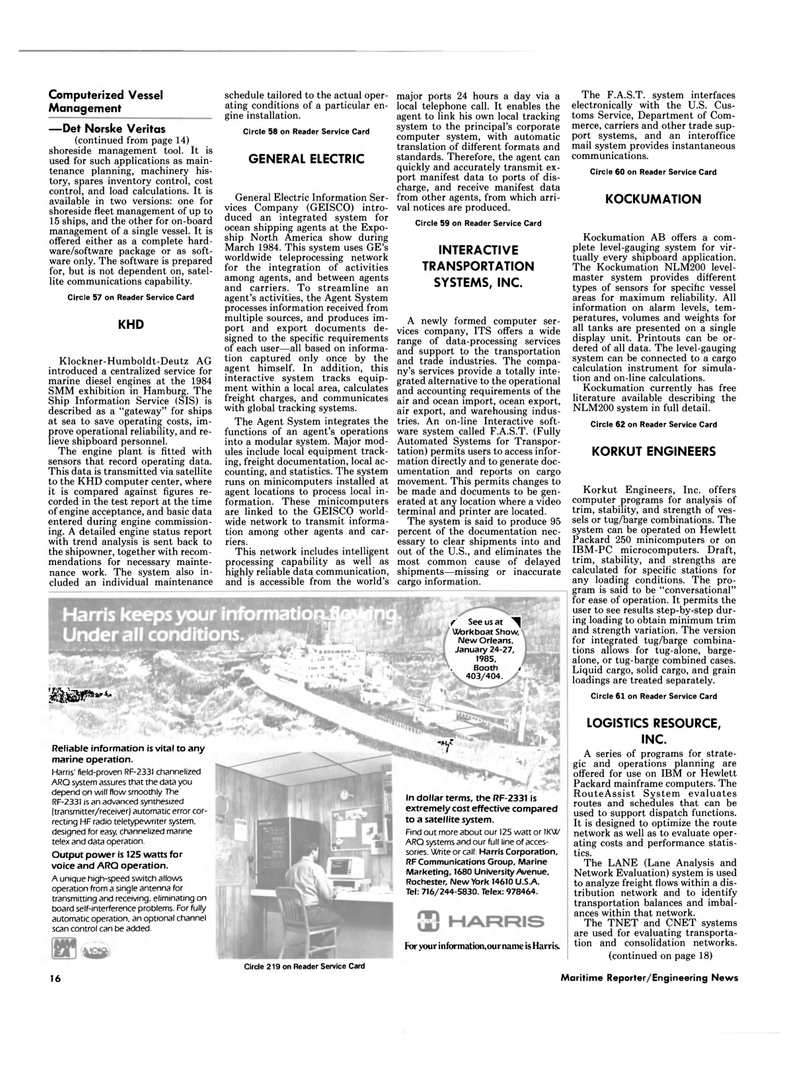
Page 14: of Maritime Reporter Magazine (January 15, 1985)
Read this page in Pdf, Flash or Html5 edition of January 15, 1985 Maritime Reporter Magazine
The F.A.S.T. system interfaces electronically with the U.S. Cus- toms Service, Department of Com- merce, carriers and other trade sup- port systems, and an interoffice mail system provides instantaneous communications.
Circle 60 on Reader Service Card
KOCKUMATION
Kockumation AB offers a com- plete level-gauging system for vir- tually every shipboard application.
The Kockumation NLM200 level- master system provides different types of sensors for specific vessel areas for maximum reliability. All information on alarm levels, tem- peratures, volumes and weights for all tanks are presented on a single display unit. Printouts can be or- dered of all data. The level-gauging system can be connected to a cargo calculation instrument for simula- tion and on-line calculations.
Kockumation currently has free literature available describing the
NLM200 system in full detail.
Circle 62 on Reader Service Card
KORKUT ENGINEERS
Korkut Engineers, Inc. offers computer programs for analysis of trim, stability, and strength of ves- sels or tug/barge combinations. The system can be operated on Hewlett
Packard 250 minicomputers or on
IBM-PC microcomputers. Draft, trim, stability, and strengths are calculated for specific stations for any loading conditions. The pro- gram is said to be "conversational" for ease of operation. It permits the user to see results step-by-step dur- ing loading to obtain minimum trim and strength variation. The version for integrated tug/barge combina- tions allows for tug-alone, barge- alone, or tug-barge combined cases.
Liquid cargo, solid cargo, and grain loadings are treated separately.
Circle 61 on Reader Service Card
LOGISTICS RESOURCE,
INC.
A series of programs for strate- gic and operations planning are offered for use on IBM or Hewlett
Packard mainframe computers. The
RouteAssist System evaluates routes and schedules that can be used to support dispatch functions.
It is designed to optimize the route network as well as to evaluate oper- ating costs and performance statis- tics.
The LANE (Lane Analysis and
Network Evaluation) system is used to analyze freight flows within a dis- tribution network and to identify transportation balances and imbal- ances within that network.
The TNET and CNET systems are used for evaluating transporta- tion and consolidation networks. (continued on page 18) 16 Maritime Reporter/Engineering News
Computerized Vessel
Management —Det Norske Veritas (continued from page 14) shoreside management tool. It is used for such applications as main- tenance planning, machinery his- tory, spares inventory control, cost control, and load calculations. It is available in two versions: one for shoreside fleet management of up to 15 ships, and the other for on-board management of a single vessel. It is offered either as a complete hard- ware/software package or as soft- ware only. The software is prepared for, but is not dependent on, satel- lite communications capability.
Circle 57 on Reader Service Card
KHD
Klockner-Humboldt-Deutz AG introduced a centralized service for marine diesel engines at the 1984
SMM exhibition in Hamburg. The
Ship Information Service (SIS) is described as a "gateway" for ships at sea to save operating costs, im- prove operational reliability, and re- lieve shipboard personnel.
The engine plant is fitted with sensors that record operating data.
This data is transmitted via satellite to the KHD computer center, where it is compared against figures re- corded in the test report at the time of engine acceptance, and basic data entered during engine commission- ing. A detailed engine status report with trend analysis is sent back to the shipowner, together with recom- mendations for necessary mainte- nance work. The system also in- cluded an individual maintenance schedule tailored to the actual oper- ating conditions of a particular en- gine installation.
Circle 58 on Reader Service Card
GENERAL ELECTRIC
General Electric Information Ser- vices Company (GEISCO) intro- duced an integrated system for ocean shipping agents at the Expo- ship North America show during
March 1984. This system uses GE's worldwide teleprocessing network for the integration of activities among agents, and between agents and carriers. To streamline an agent's activities, the Agent System processes information received from multiple sources, and produces im- port and export documents de- signed to the specific requirements of each user—all based on informa- tion captured only once by the agent himself. In addition, this interactive system tracks equip- ment within a local area, calculates freight charges, and communicates with global tracking systems.
The Agent System integrates the functions of an agent's operations into a modular system. Major mod- ules include local equipment track- ing, freight documentation, local ac- counting, and statistics. The system runs on minicomputers installed at agent locations to process local in- formation. These minicomputers are linked to the GEISCO world- wide network to transmit informa- tion among other agents and car- riers.
This network includes intelligent processing capability as well as highly reliable data communication, and is accessible from the world's major ports 24 hours a day via a local telephone call. It enables the agent to link his own local tracking system to the principal's corporate computer system, with automatic translation of different formats and standards. Therefore, the agent can quickly and accurately transmit ex- port manifest data to ports of dis- charge, and receive manifest data from other agents, from which arri- val notices are produced.
Circle 59 on Reader Service Card
INTERACTIVE
TRANSPORTATION
SYSTEMS, INC.
A newly formed computer ser- vices company, ITS offers a wide range of data-processing services and support to the transportation and trade industries. The compa- ny's services provide a totally inte- grated alternative to the operational and accounting requirements of the air and ocean import, ocean export, air export, and warehousing indus- tries. An on-line Interactive soft- ware system called F.A.S.T. (Fully
Automated Systems for Transpor- tation) permits users to access infor- mation directly and to generate doc- umentation and reports on cargo movement. This permits changes to be made and documents to be gen- erated at any location where a video terminal and printer are located.
The system is said to produce 95 percent of the documentation nec- essary to clear shipments into and out of the U.S., and eliminates the most common cause of delayed shipments—missing or inaccurate cargo information. f See us at ^
Workboat Show,
New Orleans,
January 24-27,
J985, . Booth > 403/404. " f msr*-*-
Reliable information is vital to any marine operation.
Harris' field-proven RF-2331 channelized
ARQ system assures that the data you depend on will flow smoothly The
RF-2331 is an advanced synthesized (transmitter/receiver) automatic error cor- recting HF radio teletypewriter system, designed for easy, channelized marine telex and data operation.
Output power is 125 watts for voice and ARQ operation.
A unique high-speed switch allows operation from a single antenna for transmitting and receiving, eliminating on board self-interference problems. For fully automatic operation, an optional channel scan control can be added.
In dollar terms, the RF-2331 is extremely cost effective compared to a satellite system.
Find out more about our 125 watt or 1KW
ARQ systems and our full line of acces- sories. Write or call: Harris Corporation,
RF Communications Group, Marine
Marketing, 1680 University Avenue,
Rochester, New York 14610 U.S.A.
Tel: 716/244-5830. Telex: 978464.
For your information, our name is Harris.
Circle 219 on Reader Service Card

 13
13

 15
15
